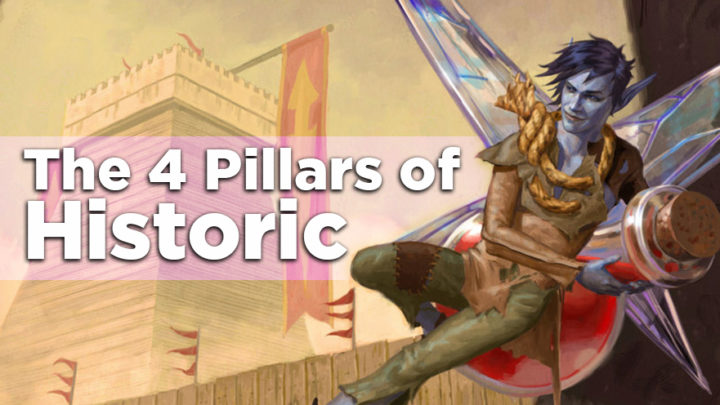After a rocky start, the Historic format is breathing new life into the MTGA experience. I admit, I was one of the early skeptics, but given the lack of Arena support for Pioneer, WotC seems to be taking Historic seriously as a competitive format, and the player base has responded in kind.
With that in mind, I find it odd that the arrival of Jumpstart in Historic wasn’t discussed more during the set’s spoiler season. Without a doubt, this is one of the most complete overhauls of an active tournament format we’ve ever seen! Jumpstart added hundreds of new cards to Historic all at once, and most of them are powerful enough to at least consider for deck-building. The diversity, complexity and sheer depth of the Jumpstart additions made it daunting to even consider what the new top tier of Historic would look like — and that was before the two previous top decks were hit by bans earlier in the week!
Nevertheless, after the first explosive, wild week of tournament play and sharing decklists online, a clear shape is emerging for the format. Players may not have completely figured out which decks are the best yet, but this past weekend’s tournaments have given rise to four broad archetypes: “good stuff” midrange, tribal, tempo, and Field of the Dead decks.
GOOD STUFF
The first pillar is the most generic of them, and also one that we’re all familiar with. You could call it “good stuff” or “three color midrange,” but the focus on ramping and resource advantage over the efficient interaction that traditionally defines “midrange” decks calls for a more specific deck designation.
Bant Ramp is the poster child for this philosophy in Standard, and that list is good enough to dominate Historic almost unchanged. The big win for Bant in Jumpstart was the humble Explore, which serves as Growth Spirals #5-8 and makes this powerhouse even more consistent without needing to invest in mana dorks.

But perhaps Jumpstart’s biggest impact in this area is that it brings other “good stuff” color combinations in line with Bant. Sultai and a variety of Jund lists can now play a similar ramp game, with Jund utilizing M21’s Radha, Heart of Keld instead of Growth Spiral to build a resource advantage. Temur Reclamation has the most unique game plan among this category of decks, but with powerful intermediate threats like Shark Typhoon and Nightpack Ambusher, it feels more midrange than combo/control.

Ultimately, all these decks want to curve out with self-replacing, sticky threats every turn until they can drop Ugin like a cartoon anvil. The overall power level in Historic makes these decks more vulnerable to both faster and slower decks compared to Standard, but Ugin remains a problem. Accordingly, The Immortal Sun has emerged as a powerful choice against these lists. By choosing non-Planeswalker threats for your own decks — or only a handful that you can board out when you bring the Sun in — you gain a huge advantage and neutralize the overwhelming dread of Ugin top-decks.

Export this decklist to Arena via MTGGoldfish!
FIELD OF THE DEAD DECKS
Editor’s Note: Field of the Dead was banned in Historic on August 24, 2020.
Breathing down the neck of today’s Standard boogeyman is the boogeyman of last Standard: Field of the Dead!

In Historic, Field shifts roles from primary win condition to “free” value engine, as the deck picks up a brace of other powerful threats. There’s some overlap between these decks and the ramp-heavy midrange lists, but the Field decks play extra ramp on top of Growth Spiral/Explore and build their game plan around the powerful land’s tokens. Field lets them go lower on interaction since zombies are clogging the board; for win-cons, you can choose between immediate threats like Craterhoof Behemoth and Kenrith, the Returned King or playing a long game Uro, Hydroid Krasis and Planeswalkers.
The Field decks are poised to attack “good stuff” decks from an unfamiliar angle: the zombies allow you to ignore even the largest creatures and immediately apply pressure after a sweeper or Ugin downtick. Slow deck match-ups in 2020 generally come down to who can resolve and protect their Planeswalkers, and an expendable army of zombies will give you an unbeatable advantage.
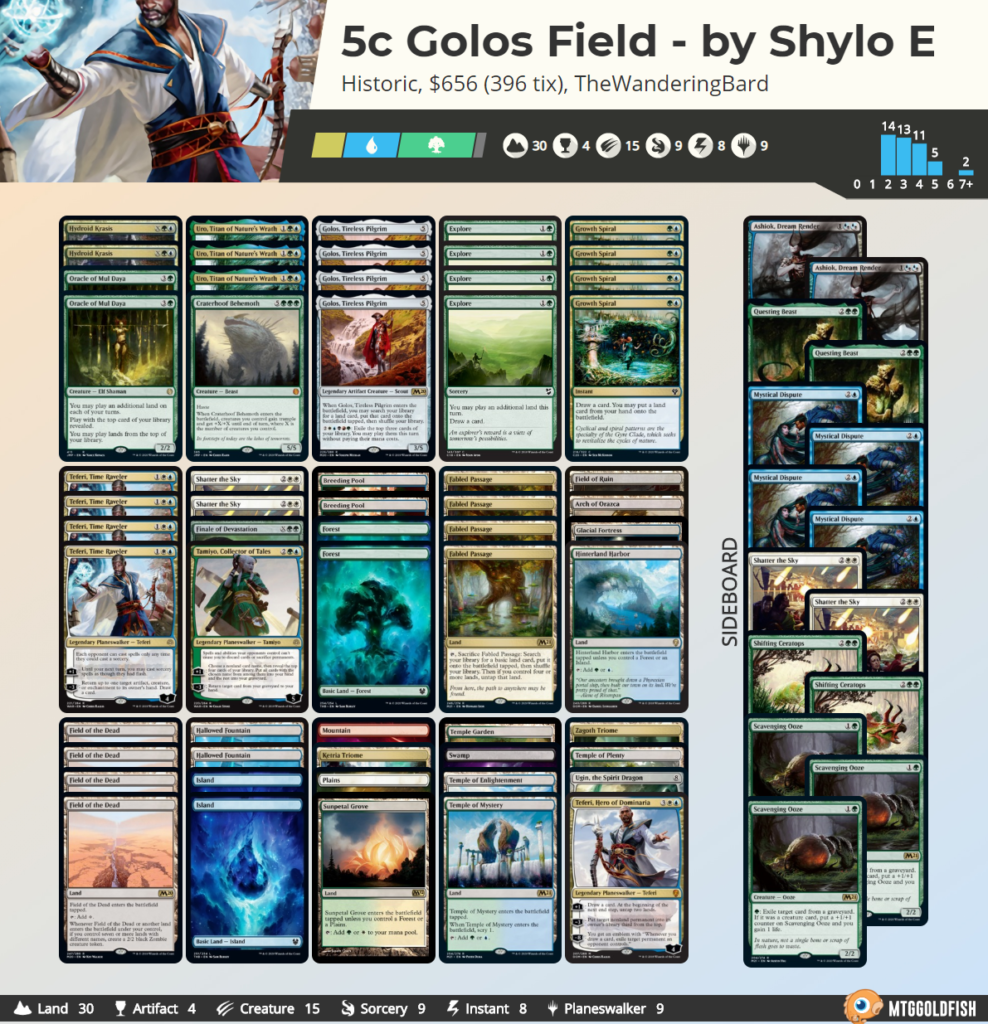
Export this decklist to Arena via MTGGoldfish!
However, this plan can be weak to explosive combo decks that aren’t phased by your board control. Flying threats can also exploit Field’s flaws, though they do have to slip between Shatter the Sky and various Planeswalkers to get there. Since the Field package allows for so much customization, the best way to break the mirror is often to play these explosive win-cons yourself. Craterhoof Behemoth and Finale of Devastation are amazing one-ofs, and Ugin and Ulamog also make the cut in successful lists. Other players may choose to return to the proven combo of Scapeshift with Teferi, Time Raveler*.
The zombies give you inevitability, but having six to ten of these explosive threats is important to avoid a long and risky grindfest in the mirror. It also saves you headaches working out how to beat now-common sideboard tech like Virulent Plague. So long as it puts the game out of reach in one turn, it’s worth considering; Kenrith, Cavalier of Flame and Terror of the Peaks are worth testing as well.
Editor’s Note: Teferi, Time Raveler has been suspended in Historic effective August 3, 2020.
TRIBAL
One major cause of dissatisfaction with current Standard is the difficulty of playing a traditional aggro strategy. Many ramp spells in Standard slow down your clock by creating blockers, gaining life, or killing creatures, while also accelerating those decks toward overwhelming threats and sweepers. Combine that with a weak crop of one- and two-drops and rare lands that mostly enter tapped, and it’s easy to see why aggro struggles to get under Shatter the Sky or around an Uro.
Jumpstart may not be legal in Standard, but it brings powerful new support for various tribal themes in Historic, which are proving uniquely well-suited to punish the midrange decks. Some 16 tribes received new support for Historic, although it’s best to look to those that already had a good pool of cards to start with. Goblins, Elves, Vampires, and Spirits seem like the decks with competitive potential, with Walls and a few others on the cusp.
While each of these powerful tribes offers unique utility effects and play patterns, they share a common advantage over other aggro decks. As I pointed out in my primer to Magic’s different aggro styles, each creature you add to the board while playing a tribal deck makes every other creature stronger. That just isn’t the case with, say, mono-black aggro, which is just a collection of individually powerful cards. When opponents try to go over the top with ramp spells instead of interacting, tribal decks get to amass an army unopposed.
This concept also applies to other aggro decks that are more than the sum of their parts. Tempered Steel and the breakout Mono-White go-wide deck that won the Red Bull Standard event this weekend also multiply in power with each card that resolves. However, in Historic, a tribe like Goblins can apply the same fast clock as a generic go-wide deck while having much stronger card quality and utility should things go longer.
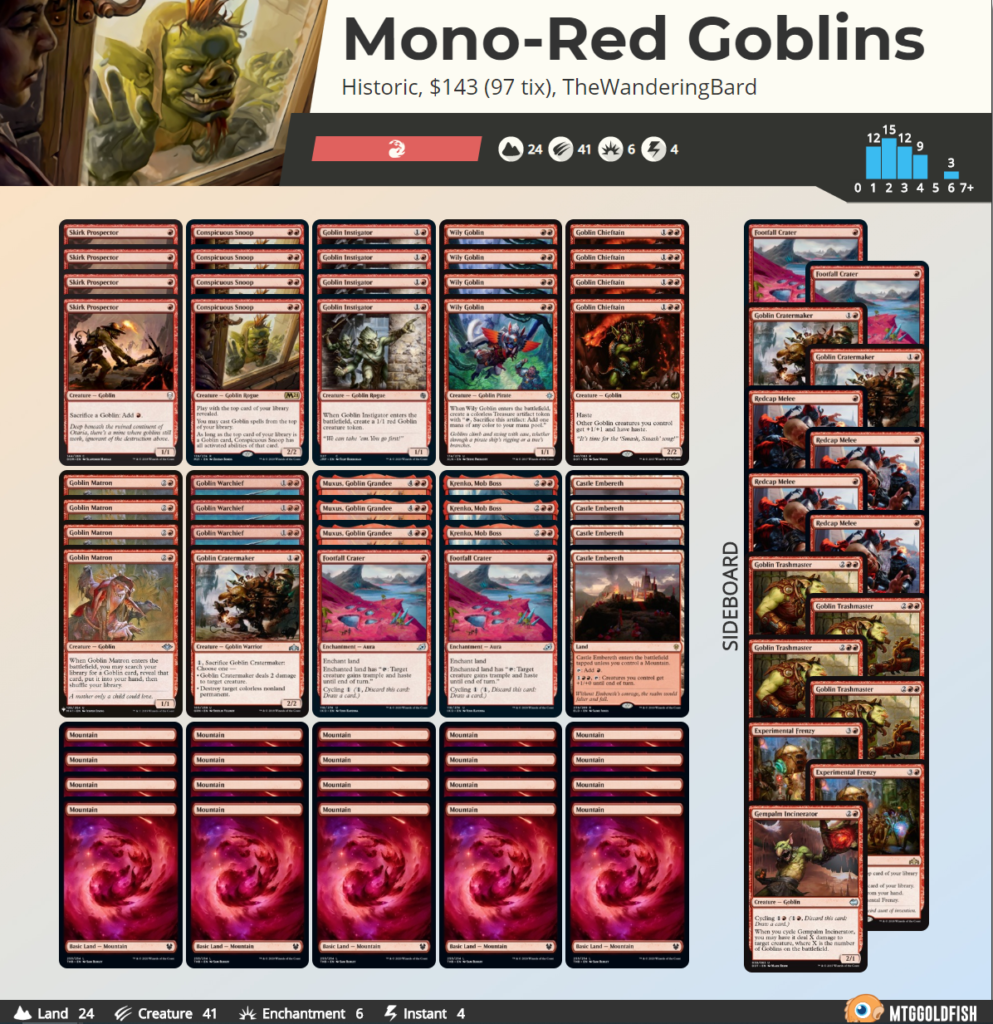
Export this decklist to Arena via MTGGoldfish!
Goblins seems like the strongest tribe and perhaps even the strongest deck in Historic overall. While it lacks the stat-boosting lords you’ll find in Elves or Spirits, Historic Goblins has become extremely explosive with the addition of Conspicuous Snoop and Muxus, Goblin Grandee. The former is almost a two-mana, no-drawback Experimental Frenzy, providing card advantage every time you can cast from your deck rather than your hand. The latter is a one-card combo that, for six mana, can often produce lethal damage out of nowhere. If you’re looking to ladder early in this format, I cannot recommend Mono-Red Goblins more highly.

Export this decklist to Arena via MTGGoldfish!
Vampires seem like the next most competitive tribe after Goblins; Sorin, Imperious Bloodlord is right up there with Muxus for strongest tribal payoffs. The one- and two-drop vampires are also far, far better in combat than the equivalent elves and goblins. Rather than try for a combo-like chain reaction of resources, Vampires is a more traditional “play-lords-and-attack” deck, backed up by extremely good removal and disruption.
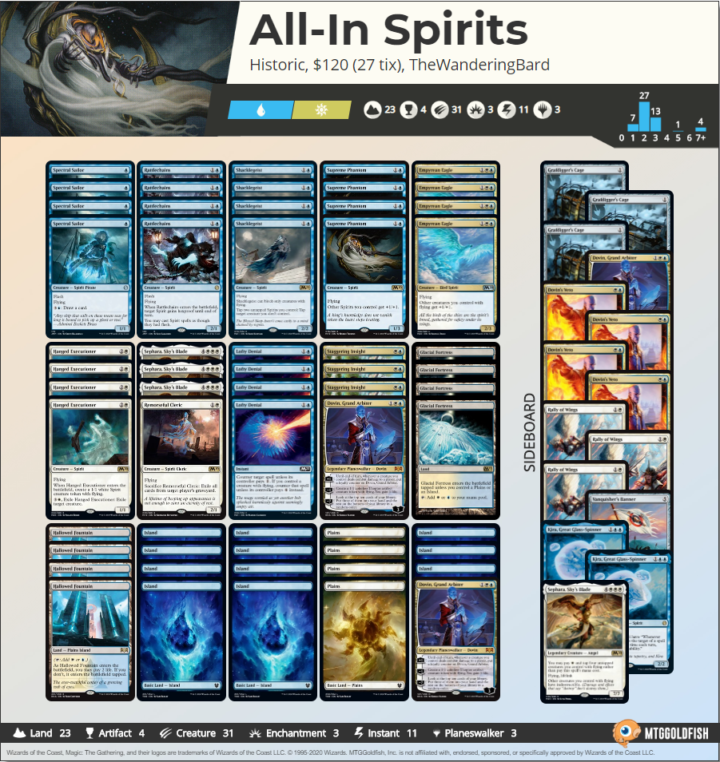
Export this decklist to Arena via MTGGoldfish!
Spirits, which is finally catching up to other Historic tribes, is also pairing powerful interaction with a tribal clock. Having an all-flying army allows the deck to ignore potential blockers — including Field of the Dead zombies — and borrow “flying matters” support like Empyrean Eagle (also a spirit!). Since it’s hard to slow the deck down with creatures, many Spirits builds focus on counterspells to crush enemy sweepers and win conditions. The countermagic and flash creatures blur the definition of spirits playstyle, leaving it somewhere between the other tribal decks and Historic’s final pillar…
TEMPO
Historic, like current Standard, hasn’t looked like the best format for “fair decks”: the kind that prioritize interaction over accelerating their own game plan. The common threats are absurdly powerful, and decks are designed to shrug off individual answers and keep going big. If you want to play efficient threats and answers right now, you need to go heavy on your answers and make sure they line up well against these popular cards.
Since so many creatures and Planeswalkers immediately refund cards and mana if they resolve, countermagic is essentially the only clean answer. However, I’d be very cautious about playing traditional control decks in this environment. Every archetype can produce a consistent stream of creatures and Planeswalkers while threatening powerful top-decks should you tap out for a sweeper or a threat of your own. Instead, the blue tempo decks have become the fourth pillar of Historic: capable of ending the game much faster without ever leaving the shields down for something nasty to resolve.
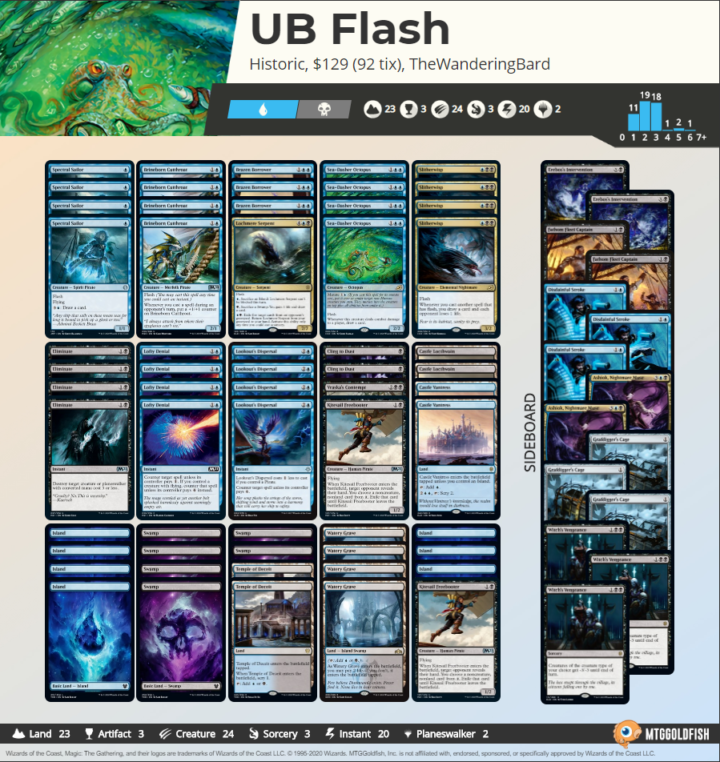
Export this decklist to Arena via MTGGoldfish!
Packed with counterspells and cheap flash creatures, these decks have only appeared in modest numbers so far, but look to have a natural edge over the other three pillars. The high ramp density in “Good Stuff” means their average draw features fewer spells that affect the board, so you can often counter all of them. Tempo’s cheap threats can beat Field decks before they get out of hand — and most are evasive, making the zombie tokens irrelevant. And while a tribal deck like Goblins is several turns faster than tempo on paper, the same reliance on lords that makes tribal so good against midrange makes them easy to pick apart with interaction.
Historic gives you the tools to recreate both the Mono-Blue and Simic Flash decks of recent Standard environments. Similar Blue-Black and Blue-Red lists are also possible, depending on which answers you want access to. You could even look at Spirits as “Blue-White Tempo,” effectively completing the “Blue + X” color pie!

While not every tempo strategy is blue, tempo decks without access to counterspells tend to focus on landing a key threat and then defending it from interaction while they race. This lines up poorly against a metagame where most decks aren’t interacting in the first place. Feather, Bogles/Auras, Kiln Fiend/Young Pyromancer “Spells” decks, dedicated discard, Reanimator, and arguably Hatebears are all examples of tempo lists without counterspells. Whether these are good or not comes down to whether you can reliably race the popular decks; you have to be faster if you want to force them into playing the kind of Magic you’re optimized for. With that in mind, I’d consider Kiln Fiend and Auras the most likely non-blue decks to break through.
IT’S TIME TO MAKE HISTORY
There you have it, folks: a nearly complete breakdown of the new Historic metagame, and what you should expect to face in it. It’s looking like a format with something to offer any kind of player, as even the control and combo options are likely to reappear once players have a firm meta to tune against. In the meantime, I recommend playing Goblins — it’s secretly a combo deck, anyway, and probably the best one in the format!
Even if you haven’t played Historic yet, the tremendous Jumpstart shake-up means you have a perfect opportunity to learn the new meta alongside everybody else. I hope you have a blast!

Tom’s fate was sealed in 7th grade when his friend lent him a pile of commons to play Magic. He quickly picked up Boros and Orzhov decks in Ravnica block and has remained a staunch white magician ever since. A fan of all Constructed formats, he enjoys studying the history of the tournament meta. He specializes in midrange decks, especially Death & Taxes and Martyr Proc. One day, he swears he will win an MCQ with Evershrike. Ask him how at @AWanderingBard, or watch him stream Magic at twitch.tv/TheWanderingBard.

